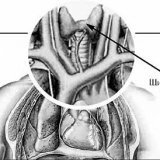Diagnosis and treatment of diabetic polyneuropathy
 The organism of patients with diabetes mellitus loses the ability to break down glucose. As a result, they develop a constant state of hyperglycemia, that is, a high sugar content in the blood. This leads to nerve damage, which is called diabetic polyneuropathy.
The organism of patients with diabetes mellitus loses the ability to break down glucose. As a result, they develop a constant state of hyperglycemia, that is, a high sugar content in the blood. This leads to nerve damage, which is called diabetic polyneuropathy.
Diagnosis and treatment of diabetic polyneuropathy is of particular importance for diabetics, since it can lead to serious consequences. According to statistics, the state of diabetic polyneuropathy develops in 30% of patients with diabetes mellitus. The greatest risk of developing polyneuropathy patients with type 1 diabetes mellitus. Risk for patients with type 2 diabetes is somewhat less, but it also exists. Most often, the nerves of the extremities are affected, and their distal( that is, located further from the center of the body) departments: the legs( first of all, feet) are affected, less often the hands.
Diabetic polyneuropathy is manifested by a decrease in the sensitivity of the extremities. Patients usually experience unpleasant sensations in the feet or hands. It can be a feeling of numbness in the limb or a feeling of cold. Often marked tingling and a feeling of "goose bumps" under the skin( paresthesia).It is also possible to combine paresthesia with painful sensations when touched.
It is important to distinguish between symptoms of polyneuropathy and ischemic disease. In both cases, the coldness of the limbs and the appearance of pain are noted. But with polyneuropathy, cooling is a subjective sensation, the temperature of the limbs remains normal, in addition, the pain sensations when walking in patients with polyneuropathy tend to weaken, with ischemia all the way vice versa.
If polyneuropathy has not been diagnosed at an early stage, nerve endings may die. This leads to the disappearance of pain, which is perceived by patients as the end of the disease. In fact, the loss of pain leads to permanent minor injuries to the limbs, while the patient does not pay attention to them, since the pain does not bother him anymore. Constant microtrauma, in turn, causes inflammation and chronic purulent processes, later trophic ulcers of the lower extremities are formed, the so-called "diabetic foot".The further development of polyneuropathy leads to a complete loss of limb sensitivity, as a result of which disruptions in coordination of movements begin. The lack of sensitivity also leads to the fact that the patient's foot is gradually deformed.
It is worth mentioning other forms of polyneuropathy.
Cardiovascular polyneuropathy is characterized by impaired cardiac activity. Her symptoms are heart palpitations at rest, a feeling of lack of air. This condition is dangerous by the development of heart attacks that occur without pain due to the dying of the nerves, which leads to necrosis of the heart muscle.
Gastrointestinal polyneuropathy occurs when the gastrointestinal tract is affected. Her symptoms are constant swallowing of the air, bloating, frequent diarrhea. For patients with diabetes mellitus, this condition is especially dangerous in that violations in the work of the gastrointestinal tract lead to malfunctions in the usual schedule of glucose uptake, which requires a serious correction of the intake of sugar-lowering drugs and all the therapy.
Urogenital polyneuropathy is expressed in a decrease in the tonus( atony) of the bladder and ureters. A consequence of this is the introduction into the body of infections, especially rapidly developing against the background of a general decrease in immunity in patients with diabetes mellitus. In men, the urogenital form of polyneuropathy also leads to the development of impotence, which affects half of diabetic patients.
Diagnosis of diabetic polyneuropathy is performed by conducting a survey with a neurologist, where the sensitivity of nerve endings is checked. It is especially important to identify the beginning polyneuropathy at the initial stage, when it is characterized by a violation of only the vibrational sensitivity. In life, people rarely notice a decrease in vibration sensitivity, since it is practically insignificant. Neurological examination is able to identify it, and hence the developing disease at the very beginning of the process.
Treatment of diabetic polyneuropathy.
First of all, treatment of diabetes itself, as the main disease, should be carried out. The goal of the treatment is to reduce the glycemia, as well as reduce its jumps after eating. To do this, often given the intake of insulin.
If the first signs of diabetic polyneuropathy are detected, it is necessary to start taking medications that have a neutropenic action aimed at protecting and restoring damaged nerve fibers.
The described manifestations of polyneuropathy are treated by performing symptomatic treatment designed to eliminate manifestations of the disease.
Diagnosis and treatment of polyneuropathy are particularly effective in the early stages of the disease, while changes in the body are still reversible. In the case of early detection of manifestations of polyneuropathy, the prognosis for the patient is favorable, provided that modern methods of treatment are applied. In neglected cases, the changes become irreversible, then the treatment of diabetic polyneuropathy can be aimed only at restraining the progression of the disease.
In this regard, a special importance for patients with diabetes acquire regular neurological examinations that can detect the disease at an early stage. Running cases can lead to the development of serious inflammatory processes and can result in the need for limb amputation.



